This pub is the former Coliseum cinema which opened in 1913 and screened its last film in the 1990s. The first permanent film show in Abergavenny was around 1912, when a Victorian corrugated-iron hall was used as the Picture Palace. The following year, the Abergavenny Coliseum Company acquired land in Lion Street and The Coliseum opened on 3 November 1913. In mid 1989, the cinema’s stalls were converted to shops, with a cinema above. By 1998, The Coliseum had become a bingo hall, with various shop units, and is now this Wetherspoon pub.
Prints and text about The Coliseum.
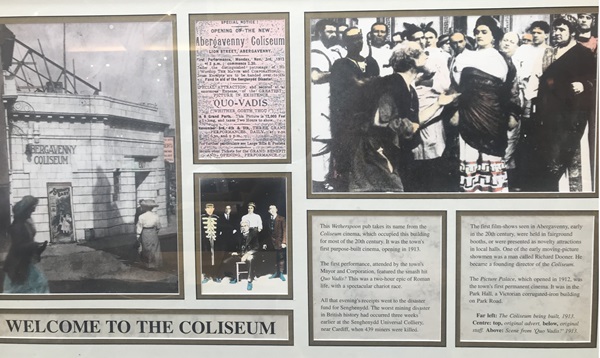
The text reads: This Wetherspoon pub takes its name from the Coliseum cinema, which occupied this building for most of the 20th century. It was the town’s first purpose-built cinema, opening in 1913.
The performance, attended by the town’s Mayor and Corporation, featured the smash hit Quo Vadis? This was a two-hour epic of Roman life, with a spectacular chariot race.
All that evening’s receipts went to the disaster fund for Senghenydd. The worst mining disaster in British history had occurred three weeks earlier at the Senghenydd Universal Colliery, near Cardiff, when 439 miners were killed.
The first film-shows seen in Abergavenny, early in the 20th century, were held in fairground booths or were presented as novelty attractions in local halls. One of the early moving-picture showmen was a man called Richard Dooner. He became a founding director of the Coliseum.
The Picture Palace, which opened in 1912, was the town’s first permanent cinema. It was in the Park Hall, a Victorian corrugated-iron building on Park Road.
Far left: The Coliseum being built, 1913
Centre; top, original advert, below, original staff. Above: Scene from ‘Quo Vadis?’ 1913.
Prints and text about Abergavenny Castle.
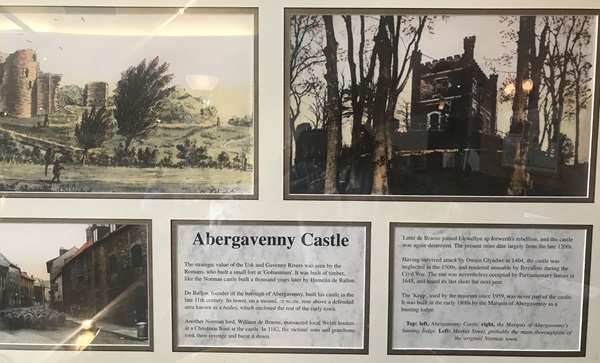
The text reads: The strategic value of the Usk and Gavenny Rivers was seen by the Romans, who built a small fort at ‘Gobannium’. It was built of timber, like the Norman castle built a thousand years later by Hamelin de Ballon.
De Ballon, founder of the borough of Abergavenny, built his castle in the late 11th century. Its tower, on a mound, or motte, rose above a defended area known as a bailey, which enclosed the rest of the early town.
Later de Braose joined Llewellyn ap Iorwerth’s rebellion, and the castle was again destroyed. The present ruins date largely from the late 1200s.
Having survived attack by Owain Gilyndwr in 1404, the castle was neglected in the 1500s, and rendered unusable by Royalists during the Civil War. The site was nevertheless occupied by Parliamentary forces in 1645, and heard its last shots the next year.
The ‘Keep’, used by the museum since 1959, was never part of the castle. It was built in the early 1800s by the Marquis of Abergavenny as a hunting lodge.
Top: left, Abergavenny Castle, right, the Marquis of Abergavenny’s hunting lodge
Left: Market Street, probably the main thoroughfare of the original Norman town.
Prints and text about siege and war.
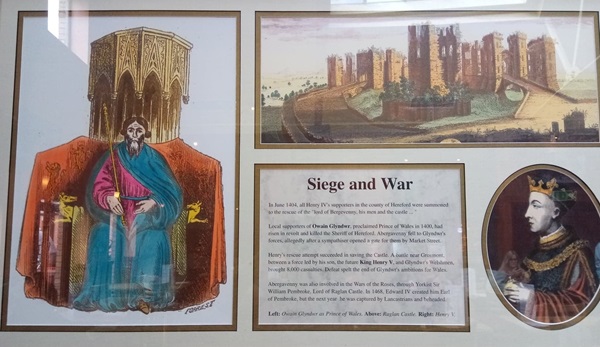
The text reads: In June 1404, all Henry IV’s supporters in the country of Hereford were summoned to the rescue of the “lord of Bergevenney, his men and the castle…”
Local supporters of Owain Glyndwr, proclaimed Prince of Wales in 1400, has risen in revolt and killed the Sheriff of Hereford. Abergavenny fell to Glyndwr’s forces, allegedly after a sympathiser opened a gate for them by Market Street.
Henry’s rescue attempt succeeded in saving the Castle. A battle near Grosmont, between a force led by his son, the future King Henry V, and Glyndwr’s Welshmen, brought 8,000 casualties. Defeat spelt the end of Glyndwr’s ambitions for Wales.
Abergavenny was also involved in the Wars of the Roses, through Yorkist Sir William Pembroke, Lord of Raglan Castle. In 1468, Edward IV created him Earl of Pembroke, but the next year he was captured by Lancastrians and beheaded.
Left: Owain Glyndwr as Prince of Wales Above: Raglan Castle
Right: Henry V.
Prints and text about Market House.
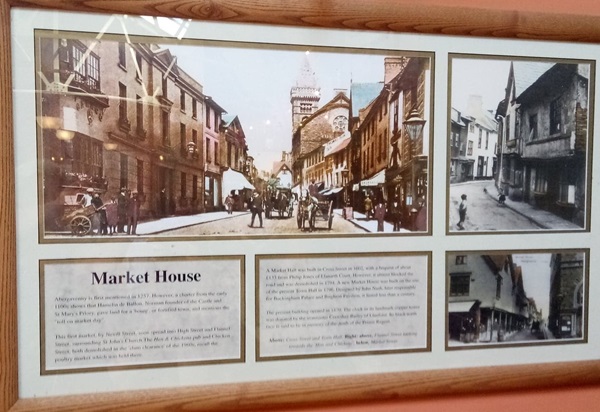
The text reads: Abergavenny is first mentioned in 1257. However, a charter from the early 1100s shows that Hamelin de Ballon, Norman founder of the Castle and St Mary’s Priory, gave land for a ‘bourg’, or fortified town, and mentions the “toll on market day”.
This first market, by Nevill Street, soon spread into High Street and Flannel Street, surrounding St John’s Church. The Hen & Chickens pub and Chicken Street, both demolished in the ‘slum clearance’ of the 1960s, recall the poultry market which was held there.
A Market Hall was built in Cross Street in 1602, with a bequest of about £133 from Philip Jones of Llanarth Court. However, it almost blocked the road and was demolished in 1794. A new Market House was built on the site of the present Town Hall in 1796. Designed by John Nash, later responsible for Buckingham Palace and Brighton Pavilion, it lasted less than a century.
The present building opened in 1870. The clock in its landmark copper tower was donated by the ironmaster Crawshay Bailey of Llanfoist. Its black north face is said to be in memory of the death of the Prince Regent.
Above: Cross Street and Town Hall
Right: above, Flannel Street looking towards the ‘Hen and Chickens’, below, Market Street.
Prints and text about the silver screen.
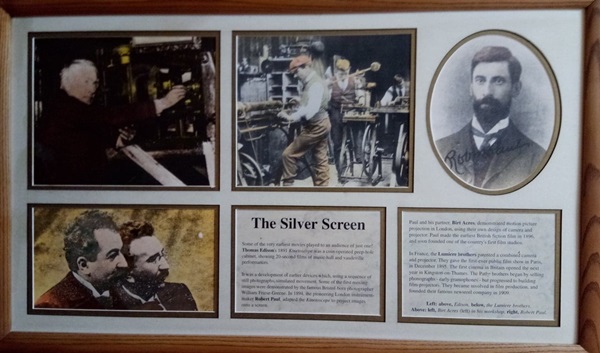
The text reads: Some of the very earliest movies played to an audience of just one! Thomas Edison’s 1981 Kinetoscope was a coin-operated peep-hole cabinet, showing 20-second films of music-hall and vaudeville performances.
It was a development of earlier devices, which, using a sequence of still photographs, simulated movement. Some of the first moving images were demonstrated by the famous Bristol-born photographer William Friese-Greene. In 1894, the pioneering London instrument-maker Robert Paul, adapted the Kinietscope to project images onto a screen.
Paul and his partner, Birt Acres, demonstrated motion picture projection in London, using their own design of camera and projector. Paul made the earliest British fiction film in 1896, and soon founded one of the country’s first film studios.
In France, the Lumiere brothers patented a combined camera and projector. They gave the first-ever public film show in Paris, in December 1895. The first cinema in Britain opened the next year in Kingston-on-Thames. The Pathe brothers began by selling photographs – early gramophones – but progressed to building film-projectors. They became involved in film production, and founded their famous newsreel company in 1909.
Left: above, Edison, below, the Lumiere brothers
Above: left, Birt Acres (left) in his workshop, right, Robert Paul.
Prints and text about transport.
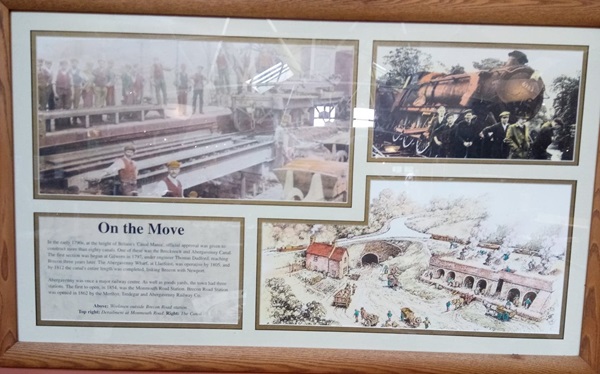
The text reads: In the early 1790s, at the height of Britain’s ‘Canal Mania’, official approval was given to construct more than eighty canals. One of these was the Brecknock and Abergavenny Canal. The first section was begun at Gilwen in 1797, under engineer Thomas Dadford, reaching Breacon three years later. The Abergavenny Wharf, at Llanfoist, was operative by 1805, and by 1812 the canal’s entire length was completed, linking Brecon with Newport.
Abergavenny was once a major railway centre. As well as goods yard, the town had three stations. The first to open, in 1854, was the Monmouth Road Station. Brecon Road Station was opened in 1862 by the Merthyr, Tredegar and Abergavenny Railway Co.
Above: Workmen outside Brecon Road station
Top right: Derailment at Monmouth Road
Right: The Canal.
External photograph of the building – main entrance.
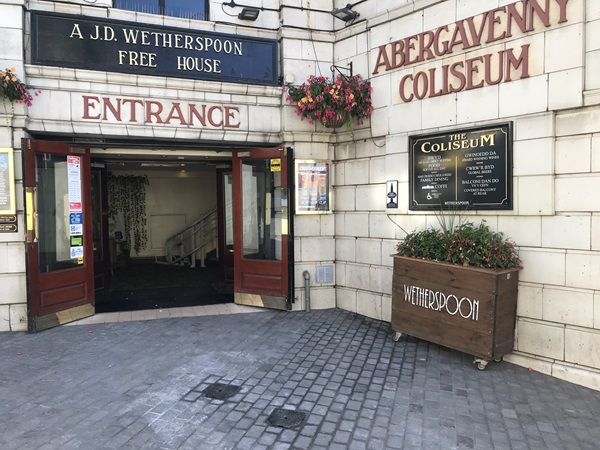
If you have information on the history of this pub, then we’d like you to share it with us. Please e-mail all information to: pubhistories@jdwetherspoon.co.uk